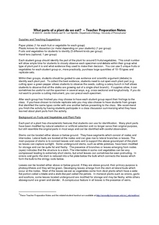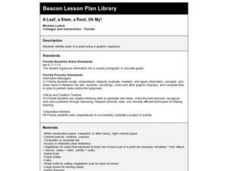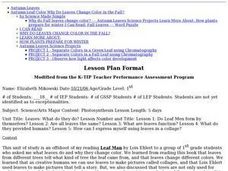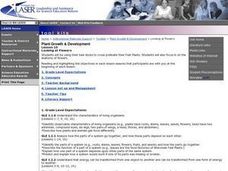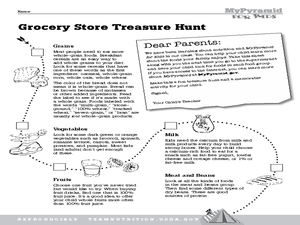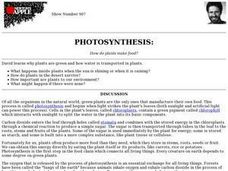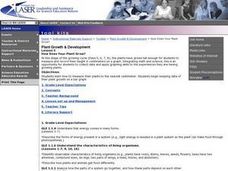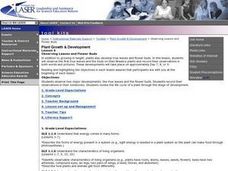Curated OER
Which Parts of a Plant Do We Eat?
Students identify the different parts of a plant. In this biology instructional activity, students examine its internal parts by dissecting it. They report their findings in class.
Curated OER
A Leaf, a Stem, a Root, Oh My!
Students conduct Internet research on plants and complete a WebQuest on vegetable plants. They use a graphic organizer to display their findings, observe actual vegetables and design a salad, noting which part of each plant is included.
Curated OER
Leaf Unit
Students complete a unit on leaves and their functions. They identify leaves and the trees they belong to, read various books, observe the process of photosynthesis on a flannel board, and create a leaf collage.
Curated OER
Dichotomous Key for Identifying Pine Trees
Middle schoolers identify the species of pine trees that are found in their area. They use unlabeled "mystery" samples and a dichotomous key to identify the pine trees to species. After identification, they use a field guide to answer...
Curated OER
Getting a Handle on Your Bee
Middle schoolers observe dried bees, carefully glue them to toothpicks, and use them for cross pollinating their Brassica plants. They also describe reasons why two similar investigations can produce different results. Finally,...
Curated OER
Looking at Flowers
Pupils use their bee sticks to cross-pollinate their Fast Plants and also focus in on the anatomy of flowers. They analyze how the parts of a system go together, and how these parts depend on each other. Finally, students describe why...
Curated OER
What is a Plant?
In this plant learning exercise, students will review the origins and adaptations of plants including the alternation of generations. This learning exercise has 8 short answer, 6 fill in the blank, and 4 multiple choice questions.
Curated OER
Watchable Wildlife Checklist
In this wildlife worksheet, learners will read over a list of 28 native animal species, their needs, and interesting characteristics. This list can be used as a checklist when out on a hike or in the school yard to identify common wildlife.
Curated OER
Reproduction in Flowering Plants
In this flowering plants worksheet, students review 11 vocabulary words associated with reproduction in flowering plants by matching the term with its definition.
Curated OER
Using the Prefixes 're' and 'non-'
In this prefixes worksheet, students complete 4 sentences using the 're' or 'non-' words in the word bank. Students make up 2 clue sentences with a prefix 're' or 'non'. Then students give a definition for 4 prefix words.
Curated OER
Taking Care of Nature (Religious)
Young scholars discover how they can help care for the earth. In this environmental protection lesson, students discuss how God created the earth and what will happen if they fail to care for the earth properly. Young scholars grow...
Curated OER
Eat Smart with MyPyramid for Kids
Students investigate food examples from the food groups to explore a healthy diet. In this healthy eating lesson, students study the food pyramid and complete related worksheets. Students also play pyramid go fish.
Curated OER
Growing Stages of a Rice Plant
Third graders make a chart to compare the growth of a wheat plant verses the growth of a rice plant. In this planting lesson plan, 3rd graders study the growth of the 2 plants and show the similarities and differences.
Curated OER
Photosynthesis: How do plants make food?
Students study why plants are green and how water is transported in them. They examine how plants respond to different amounts of light.
Curated OER
By The Pound
Students develop mathematical skills using measurement in the form of weight. They also perform calculations to find cost and strengthen estimation skills while comparing the actual price. The context for the lesson plan is in the...
Curated OER
Adaptations of the Beak
Learners examine the principles of adaptation using mouth structure of animals as an example. Students look specifically at the various shapes of beaks of birds and the bill of the platypus.
Curated OER
Forest Friends Forever
Students investigate how to use the senses to gather information about objects such as size, shape, color, texture, sound, position, and change (qualitative observations are utilized throughout this lesson plan). They investigate and...
Curated OER
CLOTHESLINE SLEUTH
Young scholars will trace origins of various forms of clothing to their agricultural sources.String a cotton cord across the top of a blackboard to resemble a clothesline. 2. Bring a variety of clothing articles to class made from a...
Curated OER
How Does Your Plant Grow?
Students measure and record their height in centimeters on a graph. By integrating math and science, students collect data and apply graphing skills to the experiences they are having growing plants. Finally, students identify how to...
Curated OER
Observing Leaves and Flower Buds
Students observe the first true leaves and the buds on their Brassica plants and record their observations in both words and pictures. They also observe two major developments: the true leaves and the flower buds and record their...
Curated OER
Cinderella: Literacy Skills Packet
In this Cinderella instructional activity packet, students can practice their literacy skills by unscrambling vocabulary words, doing a crossword puzzle, completing a story sequence activity, answering eight short answer questions, and...
Curated OER
Banana Quiz
In this ESL worksheet, students answer 10 multiple-choice questions about bananas. For example, "Bananas are an excellent source of..."
Curated OER
Papaya Reading Comprehension Activity
In this papaya reading comprehension instructional activity, students read a 1 paragraph selection pertaining to papaya and then answer 3 multiple choice questions regarding the information.
Curated OER
Cloze Activity: Rainforests
In this rainforests cloze procedure worksheet, students review a brief selection that is missing 16 words and then attempt to fill in each blank with a word they think the author might have used. A word bank is provided.


